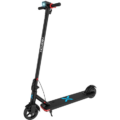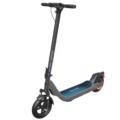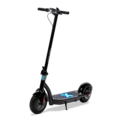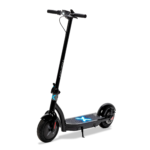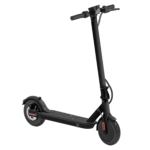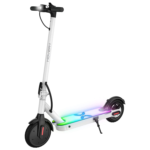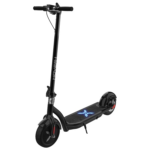- Home
- Scooters
- Electric Scooters
- Hover-1 Boss Dual Motor (Boss DM)
Hover-1 Boss Dual Motor (Boss DM)


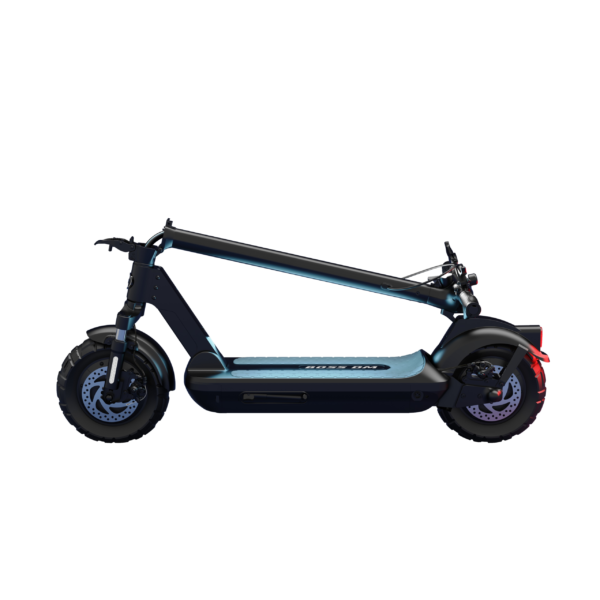

- Battery Range: 40 miles (65 km)
- Top Speed: 28 mph (45 km/h)
- Motor Power: 2 × 800 W (rated)
- Weight Capacity: 264 lb (120 kg)
- Charging Time: 7 hours
- Scooter Weight: 65.5 lb (29.7 kg)
PROS
- Dual 800W motors (2WD)
- 28 mph (45 km/h) top speed
- Up to 40 miles (65 km) range
- Full suspension front & rear
- 10″ × 3″ tubeless tires
- Single/Dual motor toggle
CONS
- IP rating not specified
- Heavy at 65.5 lb (29.7 kg)
- Up to 7-hour charge time
Table of contents
- What Is the Hover-1 Boss Dual Motor?
- How the Hover-1 Boss Dual Motor Works
- Key Specifications (clean table)
- Design & Build Quality
- Performance Fundamentals
- Battery, Range & Efficiency
- Ride Quality & Comfort
- Braking & Safety Features
- Portability & Daily Usability
- Maintenance & Care
- Weather & Seasonal Considerations
- Hover-1 Boss Dual Motor vs Alternatives
- Who the Hover-1 Boss Dual Motor Is (and Isn’t) For
- FAQs
- Glossary
- Final Thoughts
The Hover-1 Boss Dual Motor is a full-size electric scooter built for riders who want real power without stepping into extreme, high-maintenance territory. It pairs dual motors with a 48V battery, front and rear suspension, and 10-inch self-sealing tubeless tires. Additionally, if you’re cross-shopping the single-motor Hover-1 Boss R500, this Dual Motor model adds stronger starts, better hill authority, and more headroom at cruising speed. As a result, it suits commuters who face mixed terrain, taller riders who appreciate a larger deck and stable stance, and anyone who values a confident ride with app-enabled features—without the hype.
What Is the Hover-1 Boss Dual Motor?
The Hover-1 Boss Dual Motor—often shortened to “Boss DM”—is the top model in Hover-1’s Boss family. It adds a second motor for stronger starts, better hill performance, and more headroom at cruising speed. Moreover, you still get a practical folding design and a readable display, plus rider-friendly extras like cruise control, kick-to-start, and app support. Consequently, it’s designed as a capable daily scooter that tolerates rougher streets and heavier riders, yet remains approachable for first-time owners.
How the Hover-1 Boss Dual Motor Works
Electric scooters are simple machines once you break them down. However, the Boss DM combines these pieces in a way that balances power and daily comfort.
- Motors: Two hub motors—one in each wheel—convert electrical energy into motion. Because both ends provide torque, launches feel confident and traction stays balanced on uneven pavement. Additionally, you can switch between single-motor and dual-motor operation to prioritize either efficiency or power.
- Controller: Think of the controller as the scooter’s “brain.” It meters power from the battery to the motors based on your throttle input and the active speed mode. It also coordinates electronic braking, cruise control, and safety limits; therefore, it directly shapes how smooth the scooter feels.
- Battery: A 48V lithium-ion pack stores energy. While voltage defines the “push” available to the motors, capacity (Ah) determines how long that push lasts. Together, they set the ceiling for speed and range; yet, your riding style still matters.
- Throttle: A thumb throttle tells the controller how much power to send. On the Boss DM, different speed modes (Eco, Drive, Sport, and a walk mode via the app) cap acceleration and top speed to match your conditions. Consequently, you can tailor behavior to crowded bike lanes or open paths.
- Brakes: Front and rear disc brakes handle most stopping jobs, while electronic (regen) braking provides additional drag and recovers a bit of energy. In practice, this combination gives predictable lever feel and helps shorten stopping distance when set up correctly.
Key Specifications (clean table)
The table below compiles the official specifications and core hardware details for quick reference. These specifications provide a clear baseline for performance expectations.
| Block | Item | Details |
|---|---|---|
| General | Brand / Model | Hover-1 / Boss Dual Motor (H1-BSS-DM) |
| Rider Age (min) | 16+ years (manufacturer recommendation) | |
| Max Rider Weight | 264 lb (120 kg) | |
| Display | LED display with speed, mode, battery, and trip readouts | |
| Performance & Power | Motor Configuration | Dual hub motors (front + rear), 800W each; ~1,600W total rated; up to ~2,200W peak |
| Top Speed | Up to 28 mph (45 km/h) in Sport | |
| Climbing | Rated up to ~30° (manufacturer figure) | |
| Speed Modes | Eco, Drive, Sport; Walk mode via app | |
| Drive Selection | Single-motor or dual-motor toggle | |
| Battery, Charging & Electrical | Pack | 48V, 18.2Ah lithium-ion |
| Claimed Range | Up to 40 miles (65 km) per charge | |
| Charger | 54.6V / 3A; charge time up to ~7 hours | |
| Power Input | 100–240V, 50/60 Hz AC | |
| Electronic Braking | Regenerative braking integrated with mechanical system | |
| Build & Dimensions | Weight | 65.5 lb (29.7 kg) |
| Unfolded Size | 47.24 × 20.27 × 47.24 in (120 × 51.48 × 120 cm) | |
| Folded Size | 47.24 × 20.27 × 21.30 in (120 × 51.48 × 54.1 cm) | |
| Tires | 10″ × 3″ self-sealing tubeless (≈ 254 × 76 mm) | |
| Tire Pressure | Max 50 psi; recommended 40–45 psi | |
| Safety & Control | Brakes | Front & rear disc + electronic regen |
| Lighting | Headlight + rear light; on-screen indicators | |
| Start Behavior | Kick-to-start enabled by default (adjustable) | |
| Features & Extras | App | App support for locking, tracking, and walk mode |
| Cruise Control | Auto-engages after ~6 seconds at steady speed (toggleable) | |
| Suspension | Front dual shocks + rear spring suspension | |
| Warranty & Compliance | Warranty | 1-year limited parts & labor (manufacturer) |
| Compliance | Standard consumer electronics compliance statements |
Design & Build Quality
The Boss DM looks and feels like a serious commuter platform. The standing deck is long and stable, which helps larger riders spread their stance and keeps your center of gravity low. Additionally, the stem is stout and locks into place with a positive, tool-free mechanism. Because the scooter weighs 65.5 lb (29.7 kg), the whole chassis tracks cleanly over broken pavement and brickwork without feeling skittish.
Up front, you’ll see dual shocks that tame sharp edges. Meanwhile, a rear spring smooths repetitive bumps such as expansion joints and speed-table transitions. The 10 × 3-inch tubeless tires add air volume, so they soak up chatter and small imperfections while maintaining a planted contact patch. Since they’re self-sealing, small punctures often plug themselves, which reduces flats and downtime.
The cockpit is straightforward. The LED display sits centered and remains legible in daylight. Thumb-throttle position feels natural, and the brake levers offer a progressive bite. You also get an audible bell for quick alerts. Furthermore, the lighting package covers the basics: a forward headlight for visibility and a rear light to help others see you.
Fit-and-finish is tidy for a large-format commuter. Cable routing is clean, and the folding latch engages with a solid click. The deck rubber provides real traction in wet shoes, which boosts confidence during quick stops and downhill roll-offs. Consequently, the Boss DM feels composed and predictable in daily use.
Performance Fundamentals
With dual motors engaged, the Boss DM pulls away from stops with a confident surge—quick, yet not twitchy. In Drive mode, it delivers a balanced launch that fits crowded bike lanes. Switch to Sport and the throttle map turns more aggressive, so you reach a brisk clip sooner. For long, flat runs, Sport helps you maintain speed with less input; however, it uses more energy.
On 7–10% grades, the Hover-1 Boss Dual Motor behaves predictably. From a rolling start, it keeps pace without bogging, and from a stop, it benefits from a short kick and steady throttle rather than a whack-open approach. On sustained hills, dual-motor mode clearly helps, reducing the tendency to slow at mid-slope. Even so, single-motor mode remains useful on flat commutes or when you want to stretch range.
Stability is a strong suit. The wheelbase, tire width, and 65.5-pound mass work together to calm steering inputs at speed. Therefore, you can make small line adjustments without inducing wobble. On rougher surfaces, the suspension keeps the deck composed and prevents the “jackhammer” feel that solid-tire scooters often produce.
Battery, Range & Efficiency
The 48V, 18.2Ah battery offers a healthy energy supply for a daily rider. The manufacturer lists up to 40 miles (65 km) per charge under ideal conditions. In real life, your range depends on rider weight, wind, hills, start-stop frequency, temperature, and tire pressure. Accordingly, expect more range in Eco or Drive mode on flatter routes, and less if you frequently use Sport with full throttle or climb sustained grades.
A practical rule of thumb helps planning. If you weigh around 175–200 lb and ride a mixed urban route with gentle hills, assume everyday range around 60–70% of the claimed figure. That buffer covers cold mornings, headwinds, or a few “Sport” bursts. Heavier riders, constant high speeds, or repeated 8–10% hills can pull range lower; lighter riders on flatter ground may see more.
Charging uses the included 54.6V / 3A charger, and a full session takes up to about 7 hours from near empty. For battery health, try not to store the scooter at 0% or 100% for long periods. If you won’t ride for a while, leave the pack around 40–70% and top up every couple of months. In winter, let the scooter warm to room temperature before charging. Moreover, because the scooter includes regen braking, you’ll recover a little energy during long descents and gentle slowdowns. It’s not a huge amount, but it does reduce pad wear and smooths urban riding.
Ride Quality & Comfort
Comfort comes from three places: tire volume, suspension, and chassis stability. The 10 × 3-inch tubeless tires add compliance immediately. Additionally, the front dual shocks soak up square-edge hits, while the rear spring manages repetitive bumps and low-frequency oscillations. Urban cracks, shallow potholes, and curb cuts feel muted rather than jarring, which reduces fatigue on longer rides.
Ergonomics are friendly. The deck is long enough to adjust stance and relieve pressure, and the stem height positions your hands near elbow level for good control. Stem flex is minimal for a scooter in this class, which helps reduce headshake on fast bike-path sweepers. At cruising speed, you can ride one-handed briefly to adjust a glove without the bars wandering; nevertheless, two hands remain best practice.
Noise is subdued. The motors whirr under load, and the suspension stays quiet when bolts are kept torqued. Keep tire pressure within the recommended 40–45 psi window if you want the best balance between cushion and steering precision. Conversely, pressures near the maximum firm up the ride and quicken steering, so tune to taste.
Braking & Safety Features
The Boss DM uses front and rear disc brakes with electronic (regen) support. At moderate speeds, lever pull is light and progressive. At higher speeds, squeeze deeper until you feel firm bite; the regen blends in and reduces the load on the rotors. Therefore, practice hard stops in a clear area to learn how the system balances front vs rear weight transfer.
Lighting covers daily needs with a forward headlight and a rear light. For darker routes, consider adding reflective elements to your clothing and aim an auxiliary bar-mounted light slightly downward so you see road texture earlier. The kick-to-start behavior prevents accidental launches at a standstill, and—if you prefer—you can disable it in settings once you’re comfortable.
Water protection is a common rider question. The Boss DM’s guidance is to avoid water exposure and store the scooter dry. Consequently, treat puddles with caution, slow down on wet metal plates or paint lines, and inspect your brakes after riding in spray. In short, ride conservatively in poor weather and dry the scooter after.
Portability & Daily Usability
At 65.5 lb (29.7 kg), this isn’t a light scooter. Yet the fold is clean: the stem locks down quickly, and the folded size—47.24 × 20.27 × 21.30 in—fits most car trunks and utility closets. For daily stairs, plan a safe carry method: use both hands and keep the deck centered away from your legs. Because the weight sits low, short lifts feel manageable; however, multiple flights each day may become tiring.
Around town, speed modes help match conditions. Eco keeps speed and consumption low for crowded promenades. Drive fits most mixed routes and neighborhood streets. Sport is best for longer, open stretches or brief climbs. Meanwhile, the app lets you lock the scooter, track rides, and access walk mode—handy when you’re moving it through lobbies or elevators.
For security, use a hardened U-lock or chain around a solid anchor where permitted. The Hover-1 Boss Dual Motor is a substantial device; treat it like a bicycle in an urban rack. Therefore, park smart, remove accessories, and avoid predictable patterns.
Maintenance & Care
Reliability improves when you adopt a light, regular routine. Accordingly, keep the following rhythm:
- Before rides (weekly): Check tire pressure (aim for 40–45 psi), inspect the tires for cuts, confirm both brakes bite firmly, and verify the folding latch is fully locked.
- Every few weeks: Re-torque exposed fasteners (stem clamp, caliper bolts, axle nuts). Wipe the deck and contact points clean so you spot changes over time.
- Brakes: If lever travel increases, adjust caliper position or cable tension. Pads are consumables; replace them when the bite fades or you hear persistent scraping.
- Firmware/App: Open the app periodically to see if updates are available, then recheck your mode settings (cruise, kick-to-start). Small updates often improve smoothness.
- Battery habits: Avoid deep storage at 0% or 100%. If the scooter sits idle, charge every couple of months to keep the pack healthy.
- Cleaning: Use a damp cloth, not a hose. Keep water away from ports and electronics. Then, let the scooter dry before parking in closed spaces.
Create a simple schedule: quick checks weekly, a deeper inspection monthly, and a fastener/brake audit each quarter. Consequently, small tweaks prevent bigger issues.
Weather & Seasonal Considerations
Rain: Traction drops on painted lines, metal grates, and polished stone. Lower your speed, brake earlier, and stay upright over slick surfaces. Because the guidance discourages water exposure, avoid standing water and store the scooter dry.
Heat: Batteries are happiest in moderate temperatures. In hot weather, park in the shade and let the scooter cool before charging. Also, avoid sealing it in a trunk all day under direct sun; heat accelerates battery aging.
Cold: Below ~40°F (4°C), range drops and rubber stiffens. Expect slower acceleration and longer stopping distances. Additionally, cold increases mechanical resistance and reduces battery discharge capacity, so build extra time into winter commutes.
Wind: Headwinds can reduce range noticeably. Therefore, consider single-motor mode and Eco or Drive to maintain efficiency.
Hover-1 Boss Dual Motor vs Alternatives
Against commuter-class singles: If you’re moving up from a typical 350–500W single-motor scooter, the Boss DM is a different experience. It accelerates harder, holds speed against wind, and climbs better. It does weigh more, though, so stairs and daily lifts are the trade-off. Even so, the comfort gains are significant.
Against mid-power dual-motors: Many mid-power dual-motor scooters lean sportier and stiffer. By contrast, the Boss DM prioritizes comfort, everyday ergonomics, and app-based convenience. You’ll appreciate the self-sealing tubeless tires and the forgiving suspension on rough city streets.
Against off-road-style performance models: True performance machines add suspension travel, hydraulic braking, and much bigger packs—but they’re heavier, taller, and more demanding. Therefore, the Boss DM delivers strong commuting capability while staying manageable for mixed urban use.
Who the Hover-1 Boss Dual Motor Is (and Isn’t) For
Great for:
- Daily commuters who face variable terrain and moderate hills.
- Students or city riders who value a stable platform, simple controls, and a readable display.
- Taller riders who want more deck space and a planted ride.
- Owners who prefer tubeless, self-sealing tires and a suspension with real comfort.
Maybe not ideal for:
- Multi-modal riders who must carry the scooter up several flights every day.
- Minimalists who prefer ultra-light, ultra-compact frames for tiny apartments.
- Riders seeking extreme top speeds or long-travel suspension for trail use.
As a result, the Hover-1 Boss Dual Motor slots neatly into the “powerful commuter” niche, not the “track toy” category.
FAQs
1) What is the real-world range I should expect?
Plan conservatively around 60–70% of the stated maximum for mixed urban riding. Terrain, speed mode, temperature, and rider weight all play large roles.
2) Does it have cruise control and kick-to-start?
Yes. Cruise control engages after about six seconds at steady speed, and kick-to-start is enabled by default. If you prefer, you can adjust both behaviors in settings.
3) Can I ride in the rain?
Ride cautiously if you encounter wet patches, then dry and store the scooter indoors. Because water can affect components, avoid standing water and heavy spray.
4) How fast is it, and can I tune it?
Top speed reaches up to 28 mph (45 km/h) in Sport. Speed modes (Eco, Drive, Sport, and a walk mode via the app) let you tailor behavior to your route and comfort.
5) How does the braking feel?
Front and rear disc brakes provide the main stopping power. Electronic regen blends in to smooth deceleration and help reduce pad wear. Therefore, practice a few hard stops to learn the bite point.
6) What maintenance should I prioritize first?
Check tire pressure weekly (40–45 psi), verify the folding latch, and keep bolts torqued. Replace pads as needed and keep the charging port clean and dry.
7) Where can I find a “Hover-1 Boss Dual Motor overview” at a glance?
Start with this page’s Key Specifications table, then read the Ride Quality, Braking, and Portability sections for context and practical tips.
Glossary
- Ah (Amp-hours): Battery capacity. Higher Ah means more stored energy at a given voltage.
- Wh (Watt-hours): Total stored energy (V × Ah). A practical measure of range potential.
- Controller: The scooter’s power manager that interprets throttle and runs the motors.
- Regen (Regenerative Braking): Electronic braking that recovers a bit of energy while slowing.
- Stem Flex: Small fore-aft movement in the steering tube under load; less flex improves stability.
- IP Rating: Ingress protection rating for dust and water; not all scooters publish one.
- Kick-to-Start: Safety feature requiring a small push before the throttle engages.
- Speed Modes: Preset power and speed limits (Eco/Drive/Sport) for different scenarios.
- Peak Power: Short-burst maximum output; higher than continuous rated power.
- Tubeless Tire: Tire without an inner tube; seals to the rim and can self-seal small punctures.
- Self-Sealing Compound: Sealant inside the tire that plugs small holes as they occur.
- Dual-Motor Toggle: Ability to switch between one or two powered hubs.
- Torque: Rotational force that launches you and helps on climbs.
- Folding Latch: Mechanism that locks the stem upright or closed for carrying.
- Flesch Reading Ease: A readability scoring method; higher scores are easier to read.
Final Thoughts
The Hover-1 Boss Dual Motor is a well-rounded big-wheel commuter with real punch for hills and headwinds. Its dual-motor setup, tubeless self-sealing tires, and front/rear suspension deliver a comfortable ride that remains approachable for newer owners. You trade some portability because of the 65.5-pound weight, and you should treat wet conditions with care. Even so, for riders who want a stable, confident scooter that can handle everyday city routes—and still feel lively when you open it up—the Boss DM hits a sweet spot. Ultimately, those balanced strengths make it a standout daily choice.
Specifications
General
| Model The Model specifies the exact version or name of the scooter. It helps identify its unique design, features, and specifications within the manufacturer’s product line. Knowing the model makes it easier to compare options, find compatible accessories, or look up support information. | Boss Dual Motor (Boss DM) |
| Brand The Brand identifies the manufacturer or company that designs and produces the scooter. A trusted brand is a sign of quality, reliability, and good customer support. Well-known brands often have higher standards for safety, performance, and after-sales service, giving you more confidence in your purchase. | Hover-1 |
| Release Date The Release Date indicates when the scooter model was officially launched on the market. This helps you know how current the design, technology, and features are. A newer release date often means updated components, improved performance, and the latest safety or smart features. | 17 November 2025 |
| Recommended Age Recommended Age indicates the minimum age range that the scooter is designed for, based on safety, size, and ease of use. Following the recommended age helps ensure that riders can handle the scooter’s speed, weight, and controls comfortably and safely. Always check local laws and use protective gear, especially for younger riders. | 16+ |
Performance & Power
| Motor Power (Wattage) What it means: The motor power, measured in watts (W), shows how strong the scooter’s electric motor is. Why it matters: Higher wattage usually means better acceleration, more torque, and improved performance on hills or rough terrain. For example, a 250W motor is good for flat city roads and light riders, while a 500W or 1000W motor provides more power for faster speeds or climbing steep inclines. | 2 × 800 W (rated), 2 × 1,100 W (max); Dual motors |
| Top Speed The Top Speed indicates the maximum speed that the scooter can reach under optimal conditions. It’s usually measured on level ground with a fully charged battery and an average rider weight. A higher top speed allows you to travel longer distances faster, but always ensure you ride within legal speed limits and your personal comfort zone for safety. | 28 mph (45 km/h) |
| Battery Capacity Battery Capacity refers to the total amount of energy the scooter’s battery can store, usually measured in ampere-hours (Ah) or watt-hours (Wh). A higher battery capacity means you can ride longer distances on a single charge, reducing the need for frequent recharging. Keep in mind that actual range can vary depending on rider weight, terrain, speed, and weather conditions. | 48 V 18.2 Ah (874 Wh) |
| Estimated Range per Charge The Estimated Range per Charge indicates the average distance the scooter can travel on a single full battery charge. This range is calculated under optimal conditions, such as flat terrain, moderate speed, and average rider weight. Real-world range may vary depending on riding style, terrain, weather, and load. A longer range means fewer recharges and greater freedom for longer trips. | Up to 40 miles (65 km) |
| Hill Climb Ability Hill Climb Ability describes the maximum incline or slope that the scooter can handle while maintaining stable performance. It’s typically expressed as a percentage or in degrees. A higher hill climb rating means the scooter can tackle steeper hills without losing too much speed or power. Actual climbing performance may vary based on rider weight, battery charge, and terrain conditions. | Up to 33% / 30° |
| Drive System The Drive System refers to how power from the motor is delivered to the wheels. Electric scooters typically use either a hub motor (directly integrated into the wheel) or a chain/belt drive system. A high-quality drive system ensures smooth acceleration, efficient power transfer, and low maintenance. The choice of drive system affects performance, noise level, and overall ride experience. | Dual hub (2WD) |
Charging & Electrical
| Charging Time Charging Time indicates how long it takes to fully recharge the scooter’s battery from empty to 100% using the standard charger provided. Faster charging means less downtime and more time on the road. Actual charging time may vary slightly depending on battery capacity, charger output, and environmental conditions. | Up to 7 hours |
| Battery Type Battery Type refers to the specific technology used in the scooter’s battery, which affects performance, lifespan, weight, and charging time. Most modern electric scooters use high-quality lithium-ion (Li-ion) batteries because they offer a good balance of energy density, durability, and low maintenance. A reliable battery type ensures consistent power delivery and longer riding ranges. | Lithium-ion |
| Removable Battery A Removable Battery means the battery pack can be easily detached from the scooter for convenient charging and replacement. This feature allows you to charge the battery separately, swap it with a spare for extended range, or securely store it indoors in extreme weather. Removable batteries add flexibility and make it easier to keep your scooter powered up wherever you are. | Non-removable internal battery |
| Regenerative Braking Regenerative Braking is an energy-saving feature that converts some of the energy normally lost during braking back into battery power. When you slow down or brake, the motor works in reverse to generate electricity, which helps extend the scooter’s range and improves overall efficiency. This system also reduces wear on traditional brake components, leading to lower maintenance over time. | Not specified |
| Lighting Lighting refers to the built-in front and rear lights that enhance visibility and safety when riding in low-light conditions or at night. Good lighting helps you see the road ahead and ensures that other road users can see you. Many scooters include LED headlights, taillights, and sometimes brake lights or side reflectors for added safety and compliance with local traffic regulations. | Front LED headlight, rear LED taillight |
Build & Dimensions
| Scooter Weight Scooter Weight refers to the total weight of the scooter when fully assembled, including the battery. This affects how easy it is to carry, lift, and store the scooter when not in use. A lighter scooter is more portable and convenient for commuting, especially if you need to carry it upstairs or onto public transport. Keep in mind that a sturdy frame and quality components may add to the weight but also contribute to better durability and ride stability. | 65.5 lb (29.7 kg) |
| Maximum Rider Weight Maximum Rider Weight indicates the highest rider weight that the scooter is designed to safely support while maintaining optimal performance and stability. Staying within this limit helps ensure reliable acceleration, braking, and climbing ability, and it protects the frame, suspension, and motor from excessive strain. Exceeding the recommended limit may reduce performance and increase wear on components. | 264 lb (120 kg) |
| Deck Size Deck Size refers to the dimensions of the scooter’s standing platform. A wider and longer deck provides more foot space, allowing you to stand comfortably and adjust your stance while riding. A well-sized deck improves balance and stability, especially on longer rides or at higher speeds. Compact decks, on the other hand, help keep the scooter lightweight and portable. | Reinforced stem and deck; deck-mounted kickstand |
| Handlebar Height Handlebar Height refers to the distance from the deck to the handlebars, which affects your riding posture and comfort. An appropriate handlebar height helps you maintain good balance, reduces strain on your back and arms, and makes steering more comfortable. Some scooters have adjustable handlebars to fit riders of different heights, while others have a fixed height for a streamlined design. | Not specified |
| Folding Mechanism The Folding Mechanism describes how easily and securely the scooter can be folded for carrying and storage. A well-designed folding system lets you quickly collapse the scooter into a compact size, making it convenient to transport on public transit, store under a desk, or fit into a car trunk. Look for sturdy latches and safety locks to ensure the scooter stays firmly in place when folded or unfolded. | Central folding hinge with hook latch |
| Dimensions Folded Dimensions indicate the size of the scooter when it’s fully folded. This measurement shows how much space the scooter will take up when stored or carried, making it easier to check if it will fit in your car trunk, under a desk, or in a closet. Compact folded dimensions are ideal for commuters who need to bring their scooter on public transport or store it in tight spaces. | Folded: 47.24 × 20.27 × 21.30 in (120 × 51.48 × 54.1 cm); Unfolded: 47.24 × 20.27 × 47.24 in (120 × 51.48 × 120 cm) |
| Material Material refers to the primary construction materials used for the scooter’s frame and key components. High-quality materials like aircraft-grade aluminum, reinforced steel, or durable composites provide strength, stability, and a lighter overall weight. A sturdy material ensures the scooter can handle daily wear and tear while maintaining safety and performance. | Not specified |
Safety & Control
| Brake Type(s) Brake Type(s) describe the braking systems the scooter uses to help you slow down or stop safely. Common brake types include mechanical brakes (like drum or disc brakes), electronic brakes, and foot brakes. Many scooters combine multiple braking systems for added safety and shorter stopping distances. The type and quality of brakes affect your control, especially when riding at higher speeds or on slopes. | Front & rear disc + electronic brakes |
| Suspension Suspension refers to the system that absorbs shocks and vibrations while riding, providing a smoother and more comfortable ride over uneven or rough surfaces. Scooters may have front suspension, rear suspension, or dual suspension for better shock absorption and stability. Good suspension helps reduce rider fatigue and improves control, especially when riding on bumpy roads or off-road paths. | Front & rear suspension |
| Tire Type Tire Type refers to the kind of tires the scooter uses, which directly affects ride comfort, traction, and maintenance. Common types include solid (airless) tires, pneumatic (air-filled) tires, or hybrid options. Pneumatic tires offer better shock absorption and a smoother ride on rough surfaces, while solid tires are puncture-proof and require less upkeep. The right tire type helps ensure safe handling and a comfortable ride in different conditions. | 10″ × 3″ self-sealing tubeless |
| Tire Size Tire Size indicates the diameter and width of the scooter’s tires, which affect ride comfort, stability, and how well the scooter handles different terrains. Larger tires generally offer better shock absorption and a smoother ride over bumps and rough surfaces, while smaller tires keep the scooter lighter and more portable. Choosing the right tire size helps ensure a balance between agility and comfort. | 10-inch |
| Kickstand The Kickstand is a built-in stand that allows you to park your scooter upright when it’s not in use. A sturdy kickstand keeps the scooter stable and prevents it from tipping over, protecting it from scratches and damage. It also makes storing and accessing your scooter more convenient, whether you’re at home, work, or on the go. | Side kickstand |
| Water Resistance Rating Water Resistance Rating indicates how well the scooter is protected against water and moisture, usually shown as an IP (Ingress Protection) rating. This rating helps you understand whether the scooter can handle light rain, splashes, or wet roads without damage. While most scooters are not fully waterproof, a good water resistance rating adds peace of mind when riding in changing weather conditions. Always avoid deep puddles or submerging the scooter to protect its electrical components. | Not specified |
Features & Extras
| Display/Console The Display (or Console) shows important real-time information about your ride, helping you monitor your scooter’s status at a glance. Typical displays show speed, battery level, distance traveled, and riding mode. Some models also include additional features like Bluetooth connectivity, app integration, or backlighting for better visibility at night. A clear and easy-to-read display enhances safety and convenience on every trip. | LED display with speed, battery, trip & error codes |
| Ride Modes Ride Modes refer to the different speed and power settings you can choose to match your riding style or road conditions. Common modes include eco for maximum range and energy efficiency, standard for everyday balance, and sport or turbo for higher speed and stronger acceleration. Switching between ride modes allows you to customize performance, conserve battery, and ride safely in various environments. | Walk / Eco / Drive / Sport (4 modes); single/dual motor toggle |
| Smart App Connectivity Smart App Connectivity lets you pair your scooter with a dedicated mobile app via Bluetooth. Using the app, you can monitor real-time ride stats like speed, battery level, and range, adjust settings such as ride modes or cruise control, lock the scooter for added security, and sometimes receive firmware updates. This feature adds convenience and allows you to personalize your riding experience right from your smartphone. | H-1 Pro Series app (lock, modes, cruise control, motor mode) |
| Anti-Theft System The Anti-Theft System helps protect your scooter from unauthorized use or theft. This feature can include built-in alarms, electronic motor locks, GPS tracking, or remote locking through a mobile app. A good anti-theft system provides peace of mind when parking your scooter in public spaces, adding an extra layer of security to safeguard your investment. | App lock |
| Cruise Control Cruise Control allows you to maintain a steady speed without continuously holding the throttle. This feature makes longer rides more comfortable by reducing hand fatigue and providing a smoother, more relaxed riding experience — especially on flat, open roads or bike lanes. For safety, cruise control can usually be easily activated or deactivated while riding. | Yes |
| Accessories Included Accessories Included lists the additional items that come with the scooter to enhance your riding experience and convenience. Common accessories may include a charger, kickstand, bell, lights, phone holder, or carrying strap. These extras add value by making your scooter safer, easier to use, and ready to ride straight out of the box. | Scooter, 54.6V/3A charger, tools, manual |
Warranty & Compliance
| Warranty Period The Warranty Period indicates how long the manufacturer guarantees the scooter against defects in materials and workmanship under normal use. A good warranty provides peace of mind, showing the brand’s confidence in its product quality. Always check what parts are covered, such as the frame, battery, and motor, and follow the maintenance guidelines to keep your warranty valid. | Region-dependent |
| Certifications Certifications confirm that the scooter meets specific safety, quality, and environmental standards set by recognized organizations or regulatory bodies. Common certifications may include CE, RoHS, UL, or other local compliance marks, depending on your region. These certifications ensure that the scooter is manufactured to high standards and is safe and legal to use in your country. | FCC compliance |


